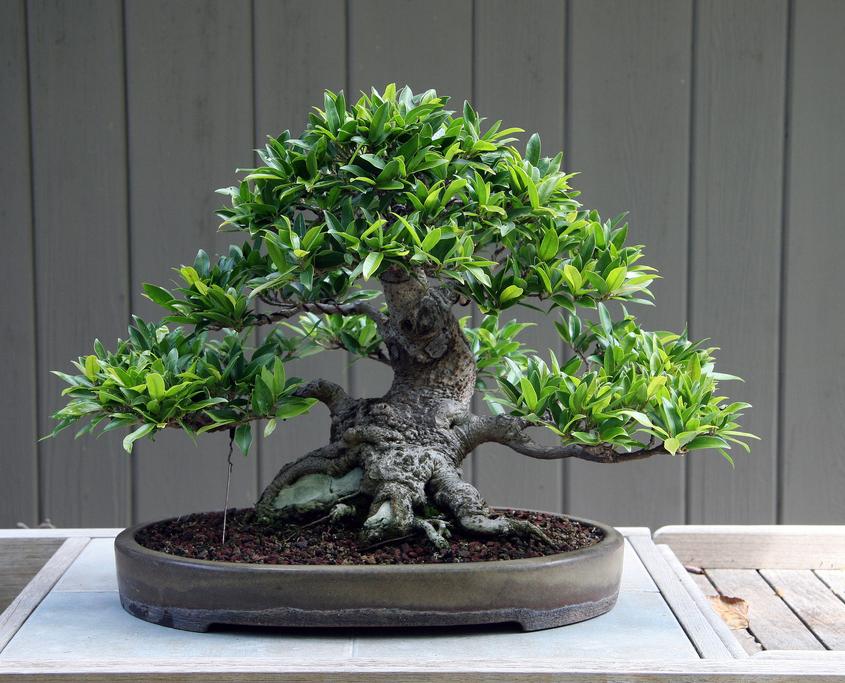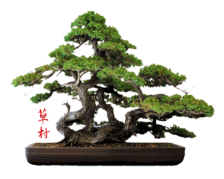Ficus Basics
By Jerry Carpenter

On the East Coast, long before moving to California was a dream, I spent my bonsai learning on “indoor” or tropical plants. I also forced, shame on me, outdoor plants to grow mostly indoors when I did not have a deck or porch to put them on. One of the common plants to work with is the Ficus tree (Ulmus species). I had other Jade, Jasmine, Eastern Olive, Serissa Japonica, Schefflera (I still have one), and finally Fukien Tea. These plants went outside in Maryland, DC, and Virginia until the temps entered the 40s and came back in to remain in the house. They mostly went into every sunny window or small glass terrarium that I had.
Today, of course, I have been converted to outside trees that mostly endure their lives comfortably on my balcony in San Jose all year unless I have temps below freezing for prolonged periods. That is rare though. I still have a fondness for the indoor types though and, yes, recently picked up a lovely old Shohin Ficus from the GSBF Convention last month. So for those are interested in Ficus, here are some basic hints on developing them as bonsai.
The Ficus is a type rainforest fig-a plant that is highly suited to bonsai treatment. Figs are mostly tropical plants, naturally growing wild in south-east Asian jungles. Many hundreds of species make up this large tree family. They are developed on the East and especially in the south.
Some species have tiny flowers that are completely enclosed in the developing fruits between the leaves. Fruiting is not very common in bonsai though. Figs prefer full sun to part shade and humus-rich, moist, but well drained soil and shelter from cold winds. They will do very well in our bonsai mix that we use, just include a bit more organics in the mix.
Most Ficus produce aerial roots from the branches and trunk. Some overgrow their pots with these root structures. Incorporating them into the design of the tree is a controversial issue for bonsai. The roots break very easily at first, but strengthen and become strong when they reach soil. The striking aerial roots of the banyan fig are often featured in clasped-to-rock styles, in groves and rock plantings.
As bonsai, the leaves vary in size on mature trees from ½” to 3” depending on the species. I have been successful in reducing leaf size in the past. To help reduce the leaf size, you can defoliate near the end of summer. Cut the leaves about ¼” the stem. Prune throughout the whole year by cutting back to about two or three leaves. Thin out larger leaves.
Ficus are strong feeders, they can go a couple of days without watering, so water them sparingly to make sure you do not cause the root system to rot. However, they will sulk, lose leaves, if the roots start drying too much.
For us in the Bay Area, not quiet tropical living, the tree should be kept indoors during the winter under fluorescent lights, in window boxes on a sunny warm part of the house, in a winter greenhouse, or as I do on my smallest ones, keep them in a mini greenhouse in the window. I have found that picking up these mini greenhouses on sale has allowed me to over winter more of my smallest plants.
Ficus tolerate low light at times but prefers warm light. Protect from frost and draughts. They should be kept inside from minimum 59°F to 71°F in the winter. I have kept some of my tropical plants outside in San Jose until temps read mid 40s with excellent results. I currently have two ficus and one root-over-rock Schefflera that come in and out of the apartment all the time.
Remember to place them in a window letting in plenty of light. This plant does not like sudden changes in temperature or the sort of draughts that can arise inside homes. I must confess the Ficus I got at the convention did not take kindly to the change in environment. After bringing it home, it began to go yellow and drop leaves aggressively. I did not panic, I knew this would probably happen, and in a short time it has recovered well and is starting new growth.
With our planting medium, watering must be plentiful during the spring and summer period while the plant is outside. You may even need a humidity tray in warmer areas all the time. In winter, allow the soil to dry out before watering. Spray the plant often to maintain humidity. I spray the leaves of the ficus once or twice a week. Remember that indoor climates are much drier than outside. I also place them outside on rainy days. They just seem to perk up so well after a good rainy day.
For more info see Ficus Species Guide
